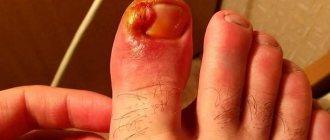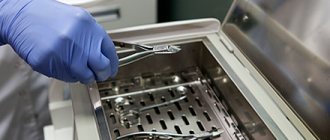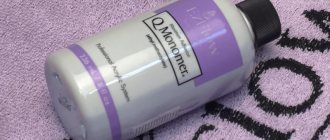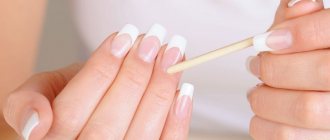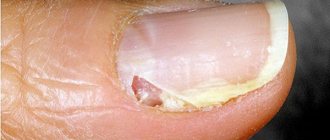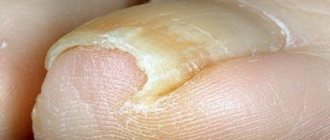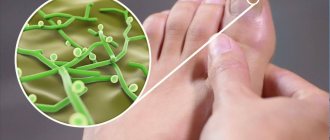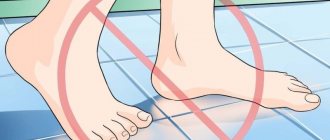Why do shoes need to be disinfected if they have fungus?
If you have toenail fungus, you should definitely disinfect your shoes.
Disinfection of a patient's shoes with nail fungus is one of the stages in the fight against onychomycosis. Pathogenic microorganisms that cause this disease can remain active for a long time not only on human skin, but also on the surface of various objects and things with which the person comes into contact. First of all, this concerns shoes. If the patient does not take care of it, then even the correct treatment will not bring him the desired result, since he will not have time to get rid of the pathogenic fungus in his shoes, which is fraught with re-infection. Wearing shoes or boots infected with pathogenic microflora will result in its transition to healthy skin and nails, which the person managed to successfully cure.
To avoid such a course of events, you need to know exactly how to disinfect shoes with nail fungus. Patients with onychomycosis should take care in advance of the availability of special means that help destroy the infectious agent on things and other objects that they regularly use.
General information about shoe disinfection
Before treating shoes with foot or nail fungus, you need to study in detail the disinfection methods and choose the most suitable one. In addition, it is important to take into account the advice of professional dermatologists and complete all preparatory steps.
Processing methods
If onychomycosis has been detected, then treating shoes should be the very first step in getting rid of this unpleasant disease. It should be carried out immediately after identifying the slightest signs of the disease. This measure will help prevent further spread of the disease and protect other family members from infection.
Fungal spores are distinguished by their tenacity and can exist even in the most extreme conditions. The only 100% way to defeat them is long-term heat treatment at a temperature of 100 degrees above zero. This method for processing shoes is unacceptable, so you should resort to the following means:
- Special sprays to combat fungus . With their help, you can not only disinfect shoes, but also remove unpleasant odors. The good thing about the spray is that it is easy to use on wardrobe items. It can penetrate even the most difficult to reach places.
- Antiseptics . These compounds disinfect the shoes of an infected person, which helps prevent the spread of spores throughout the apartment.
- Electrical appliances . With the development of technology, special devices have been invented that fight the disease and help dry shoes. Within a few hours after their use, wardrobe items can be worn.
- Folk remedies . This is the easiest, most effective and safest way to get rid of toenail fungus. Over the years of practice, traditional healers have developed many recipes that defeat fungal spores.
Whatever processing method is used, it is necessary to repeat the procedure at least once every 2 weeks. After getting rid of the disease, you need to continue preventive disinfection of wardrobe items.
Dermatologist advice and preparations
When dealing with nail plate fungus, it is important not only to choose the right product, but also to follow safety precautions. The slightest carelessness can lead to infection of other family members, which will make treatment even more difficult and costly from a financial point of view.
Experienced dermatologists advise the following:
- Before processing, you must wear medical gloves. This precaution will help to avoid accidentally getting fungal spores on your fingernails.
- Some sprays and solutions can cause an allergic reaction in humans. Because of this, you should protect yourself from getting the substance used on open areas of the body.
- To prevent antifungal sprays from entering the respiratory tract, you need to use various protective masks.
- It is best to treat shoes not indoors, but outdoors.
- Sprays should be sprayed from a short distance. This way they will cover not only the inner surface of the boot, but also the outer one.
- Most nail fungus remedies are toxic and should be kept out of the reach of children and pets.
In order for the disinfection of shoes for nail fungus to give the desired result, you should perform several simple preparatory measures. They all involve manipulating a piece of clothing and pre-cleaning it.
The following actions must be performed:
- Each shoe is thoroughly washed from the outside and wiped from the inside with a damp cloth.
- The insoles are removed. They are separately treated with the selected antifungal agent and dried.
- If shoes have laces, they are also removed and disinfected.
Only after completing the above steps can you begin to process the boot itself.
General processing rules
Treating shoes against fungus must be carried out in accordance with certain rules. Compliance with them guarantees the desired result. It’s worth clarifying right away that not all shoes can withstand the standard stages of disinfection from pathogenic microflora. As a rule, cheap products quickly become unusable due to exposure to aggressive compounds that help clean them of nail fungus. Therefore, the patient should be prepared to change his favorite pair of shoes.
General processing rules apply more to quality products made from durable materials. Do not forget that shoes will have to be disinfected many times. For fungal nail infections, this procedure should be performed regularly.
Interested in how to disinfect their shoes from fungus, many patients with onychomycosis learn about the existence of special liquids for disinfecting various products. According to the instructions, they should not be poured in large quantities inside the shoe or boot. It is best to thoroughly saturate the lining with the composition. In general, treatment of contaminated shoes for toenail fungus follows the following plan:
- You need to completely unlace your shoes if necessary;
- Next, you need to moisten a cotton cloth or cotton pad in a disinfectant solution;
- They should thoroughly wipe the inside of their shoes;
- Then you need to tie the shoes in a plastic bag and leave them like that for several hours;
- Upon completion of treatment, you need to thoroughly ventilate the shoes and dry them well.
The toe and heel areas of shoes are disinfected with special care, since this is where fungal accumulations are most often found.
Shoe processing procedure
Without disinfection, fungal mycelium retains vital activity and the ability to reproduce for a long time. If the skin infection has been eliminated and seasonal shoes can be worn again, there is a risk of recurrence. It is not advisable to subject leather products to heat treatment; the spores of the pathogen will not be killed, but the item will be hopelessly damaged. Therefore, special products based on zinc and other antimycotic substances are used, disinfection is carried out at least 2 times every 30 days.
Algorithm for how to treat shoes during the treatment of pathology and after therapy:
- Shoes must be washed and dried thoroughly.
- If there are insoles, they are removed.
- Use a cotton or gauze swab with the product to wipe the inner side surface.
- Shoes, boots, sneakers are left for 15 minutes, then a clean swab with solution is taken and the heel, toe and insoles are wiped again on both sides.
- A clean swab soaked in the product is placed in the toe box.
- The shoes are placed in a plastic bag, tied well and placed in a warm place.
- After 24 hours, boots or shoes are removed and aired for 2 days to eliminate the smell of the disinfectant solution.
To prevent an allergic reaction on the feet, it is recommended to wipe the treated parts with ammonia. The entire procedure is carried out wearing rubber gloves.
Pharmacy products for disinfection
Special solutions help disinfect shoes from nail fungus. They can be bought at any pharmacy. After this treatment, the shoes will be disinfected and safe for further use. It is disinfected with the following known solutions:
- Chlorhexidine. The product is effective against dermatophytes and yeast-like fungi. The inner surfaces of shoes are treated with chlorhexidine. 1% concentrate kills infection well. After the procedure, shoes must be thoroughly dried;
- Bitsin. Another useful solution with disinfectant properties. He is able to cope with fungal infection pathogens. The substance also successfully combats unpleasant foot odor. To prepare a disinfectant solution based on Bitsin, you need to mix the contents of 1 ampoule with a tube of water that comes with the complex. Afterwards, the solution is actively sprayed onto the required surface.
Both funds are budgetary. Therefore, anyone can afford such care for the shoes of a patient with onychomycosis.
Basic information about drugs
Their work is based on the principle of normalizing water balance and activating the immune barrier. Also, some components directly affect organisms, disrupting their reproduction process.
Mycostop-Spray
It is used in the prevention of fungal infection after close contact with potentially infected objects and surfaces (swimming pool, beach, bathhouse, public shoes, skates, rollers).
Active components
The active component TETRANYL U is a modern derivative of undecylenic acid, which is found in sebum and helps protect the skin from fungus.
The formula is several times superior to undecylenic acid and is effective against all types of fungus. Upon contact with a fungus, it neutralizes microorganisms in the shortest possible time and improves the patient's condition .
Mode of application
For the purpose of prevention, the drug is sprayed on the skin of the feet, nails, and areas between the toes. It should be applied after touching contaminated surfaces, the sooner the better.
To treat shoes, spray inside each shoe 3-4 times a day. If the fungus is present, it dies completely after 2 weeks.
Advantages:
- effective against all types;
- easy to use;
- the bottle can be extended for a couple of months;
- does not contain alcohol.
Dezavid
When it comes to eliminating infections without harm to health, DEZAVID has no analogues. The product is used in the treatment of tuberculosis, hepatitis, fungal diseases, etc. The products are safe for humans, and decomposition products do not poison the environment. The substance is hypoallergenic. After applying the product, a film forms on the surface, which lasts up to 3 days.
Directions for use: moisten a cotton pad and apply to the surface with massaging movements. Use 2-3 times a day. In a week the disease will subside.
Bitsin
A spray for disinfecting shoes that helps prevent and eliminate fungus and the unpleasant odor of sweat, which is also caused by pathogenic microorganisms.
Instructions:
- Open the bottle.
- Remove and carefully break the ampoule with the suspension.
- Dissolve its contents in water.
- Close the bottle securely.
- Shake the liquid well.
- Spray the inside of the shoe.
Formidron
The substance is designed for external use . A small amount of Formidron is applied to the area of skin that produces abnormal amounts of sweat once a day.
Sometimes the frequency increases 2-3 times a day. Before applying the drug, the skin must be washed, cleaned of dirt and sebum. If your skin is very sensitive, do not wash it with soap with a high pH level.
This substance is classified as potent and toxic, so the dose and frequency of use must be administered by a qualified specialist.
Important!
After shaving, it is recommended to wait a day before applying Formidron.
Chlorhexidine
For local use in dentistry, dermatology and surgery. The substance is used to treat wounds, burns, and fungal formations. The liquid does not contain alcohol, has no taste or smell, and is quickly absorbed.
Instructions: Apply the liquid to a cotton swab and wipe the area of infection 3-4 times a day, or apply lotions for 10-15 minutes.
Miramistin
The active ingredient is benzyldimethyl, which belongs to the class of surfactants (surfactants). Opened in the 1970s in the USSR. Initially, the substance was supposed to be used to disinfect the surfaces of spaceships , but later it entered the wide consumer market.
Effects:
- antiseptic;
- immunostimulating;
- regenerative.
The algorithm for the antiseptic effect is based on the effect on the lipid walls of the cell. In this case, the throughput of the wall is disrupted and the bacteria die. The drug is not dangerous for the cells of the body.
Stimulation of phagocytes and macrophages helps normalize the functioning of the immune system. By absorbing purulent masses and liquid, the substance eliminates exogenous organisms, which helps the body heal wounds faster.
In addition to this article, we also recommend that you familiarize yourself with the materials: how can fungus be dangerous, what tests need to be taken, and how is it transmitted in general?
Laina
Laina includes polyhexamethylene guanidine hydrochloride (2.5%) - a transparent blue-green liquid with a strong antibacterial effect.
Pharmacological properties
Laina has a wide range of antimicrobial effects against pathogens of infectious diseases of bactericidal (including tuberculosis), viral (adenoviruses, herpesviruses) and fungal origin. It belongs to the class of safe substances and is dispensed without a doctor’s prescription.
The drug is used for the prevention and disinfection of skin and shoes. Apply a few milliliters of solution to a napkin and wipe the affected area or the inside of the shoe.
Repeat the procedure several times a day to obtain maximum effect. Can be diluted in water and sprayed with a spray bottle.
Alaminol
Alaminol is a transparent, bluish-colored product. Mixes well and dissolves in water. Used for disinfection. The main active ingredient is alkyldimethylbenzylammonium chloride.
Effectively eliminates viruses of varying degrees of mutation and nature of origin, fungal and mycotic infections. Equally effective when applied to the skin, sprayed indoors, compresses and lotions.
Apply a small amount to a napkin and treat the infected area 5-6 times per tap. The course of treatment is 1 week.
Special sprays
Anti-fungal sprays are absolutely safe
Many patients prefer to use shoe spray against pathogenic fungus. There are several options for such funds:
- "Mycostop" spray. It will disinfect shoes from various types of mycotic infections. It's very easy to use. The drug does not leave any marks on shoes, which is another advantage. This spray is suitable for treating shoes from fungus and the nails themselves, which have been infected with a mycotic pathogen. To completely disinfect boots or shoes, you will need to use the product 5 or more times in a row. It is best to do this before bed to allow the composition to remain inside the shoe overnight;
- "Dezavid." A well-known remedy for disinfecting shoes against fungus. This aerosol gets rid of not only mycoses, but also pathogenic bacteria. It is also effective against mold that grows in the bathroom. To disinfect clothes or shoes, just spray this composition on its surface. After a few minutes, no trace of the presence of pathogenic microflora remains on the shoes.
Special means for combating fungus are absolutely safe for human health if used strictly for their intended purpose in accordance with the instructions.
Types of disinfectants
Medical chemicals are produced in the form of high concentrations for preparing solutions, in the form of sprays, and special wipes. There are also devices for exposing spores to ultraviolet light. Using antifungal products not only eliminates unpleasant odors, but also prevents re-infection.
When purchasing, first of all, pay attention to the instructions for the drug; it must correspond to the material from which the shoes are made and the active substance in the composition (against dermatophytes, yeast, candida).
The most effective and popular means to treat shoes against fungus are as follows.
Mycostop spray
A powerful remedy against fungal and bacterial infections. It has no age limit and can be used to treat children's shoes, slippers and sneakers. Effective for disinfecting shoes when treating fungus. Available in the form of lotion, paste and spray, it meets the requirements of international standards.
Recommendations for use:
- spray is sprayed inside the shoes;
- greater concentration on insoles;
- left for 12 hours.
Mycostop spray is used for preventive disinfection of the skin on the feet, toes, and is applied to the nails. The course is 5 days after visiting swimming pools, gym showers, saunas, solariums.
Dezavid
The disinfectant is available in the form of a spray, stops the proliferation of bacteria and destroys fungus, preventing the spread of re-infection. The composition does not contain strong chemical components, so the spray is hypoallergenic, odorless, and does not harm materials.
How to treat shoes with foot fungus using Dezavid:
- at a distance of 25 cm, spray the disinfectant onto the inside of the shoes with 3–4 pumps;
- left for 10 minutes;
- for application to the surface, it is possible to use a swab soaked in the product.
During the treatment of the disease, the procedure is performed every day. To eliminate unpleasant odors, apply the spray as needed.
Dezavid – hypoallergenic disinfectant spray
Bitsin
The product is produced to protect against fungus within 40 days, while eliminating odor well. Designed for preparing a solution whose shelf life is 5 years. The kit includes an ampoule and a bottle of spray.
Preparation of disinfectant solution:
- Remove the cap from the spray bottle.
- Break off the top part of the ampoule (3 pcs.).
- Pour the contents into a spray bottle.
- Return the cap to its place, shake the bottle.
- Apply to the inner surface until damp.
- The greatest effect is achieved if the shoes are wet.
It is recommended to treat new shoes with Bitsin. One set is enough for 3–4 disinfections.
Bitsin - a set of a sprayer and an ampoule with a disinfectant
Formidron
The drug has an antiseptic and deodorizing effect, has a detrimental effect on bacteria due to the Formaldehyde included in the composition. Scented components effectively protect against sweat and odor. The antiseptic is available in a glass bottle with a capacity of 100 mg.
Apply the product to the skin of the feet once in the morning for 30 minutes, then rinse thoroughly. Tannins in Formidron partially block the ducts of the sweat glands, eliminating a favorable environment for fungal and bacterial proliferation.
The substance is quite toxic; you need to wear rubber gloves when handling shoes.
Disinfection is carried out as follows:
- The inside of the shoes is wiped with a swab soaked in the composition;
- the insoles are removed and processed on both sides;
- A swab with solution is placed in the toe of the shoe.
The shoes are put away for 12 hours, after which time they are ready to wear.
Formidron is an antiseptic and deodorizing drug
Chlorhexidine
The antiseptic drug is available in the form of solution, suspension and spray. The active substance chlorhexidine digluconate will change the structure of microorganism cell membranes, which leads to their death. Destroys spores and mycelia, preventing the development of fungal infections.
The solution is used to treat the affected areas of the epidermis of the feet with onychomycosis, and to disinfect the shoes.
Special napkins
Wet disinfectant wipes are impregnated with antifungal and antibacterial agents. Their main function is not to treat the infection, but not to allow microorganisms to reproduce. The substance in the composition is non-aggressive, hypoallergenic, does not cause irritation to the skin of the feet, it can be used to disinfect shoes and feet for children.
In terms of its effect on fungal spores, it is not inferior to other means; it is used to treat shoes in saunas and solariums. Before visiting public places, you must wipe your feet, fingers, toenails and provided shoes. Disinfect your skin after visiting the gym and swimming pool showers.
Disinfection wipes
If a patient with onychomycosis decides to use special disinfectant wipes, he will no longer be bothered by the question of how long the fungus lives in shoes. Antifungal and antibacterial agents of this type do not allow pathogenic microflora to multiply. However, they cannot completely destroy it on their own. For this purpose it is necessary to use additional devices.
The wipes are impregnated with a special substance that does not cause allergic reactions in humans. This means that after using them, a patient with onychomycosis will not experience skin irritation. Because of this feature, the product is allowed to be used to disinfect children's shoes.
Ultraviolet disinfection
Direct sunlight is harmful to fungal microorganisms. Their ultraviolet spectrum may well compete in effectiveness with chemical fungicidal solutions.
On a hot summer day, it is enough to place your shoes in the sun, after removing the insoles from them. Leave for this treatment for the whole day, or better for 2-3 days, weather permitting. Additionally, you can wipe with an antiseptic.
The ultraviolet effect is also used in devices produced by individual manufacturers as an effective way to suppress the vital activity of pathogenic microflora. Drying the shoe surface from the inside creates unfavorable conditions for further growth of bacteria. For the purpose of prevention, it is enough to turn on the device 1-2 times a week and leave it for the period specified in the instructions.
Electrical appliances
A special device can help destroy the fungus inside the shoes of a patient who suffers from onychomycosis. A shoe dryer equipped with gas-discharge or ultraviolet lamps is suitable for these purposes. These devices operate on mains power or batteries.
This method of disinfecting shoes from fungus has many advantages. Many patients choose it, since after drying the boots do not need to be additionally ventilated.
Scientific studies have shown that regular drying of shoes with this device allows you to achieve the following results:
- The unpleasant odor disappears;
- Spores of pathogenic fungi and pathogenic bacteria are destroyed;
- Shoes are safely dried from moisture.
To enhance the effect of the device, it is recommended to combine this treatment with disinfecting shoes with a special product, purchased at a pharmacy or prepared on your own.
Ultraviolet devices
Some chemicals have a detrimental effect on the condition of the processed products, which is why they have been replaced by devices with UV radiation, offering complete disposal of spores.
Hot ultraviolet rays destroy all types of fungal spores. Soon only ultraviolet light will be used in the treatment of nail fungus and shoe treatment!
Disinfection with improvised means
If desired, you can disinfect your shoes from fungus using homemade products. They help cope with unpleasant odors and destroy pathogenic microorganisms. Homemade formulations work best against yeast-like microorganisms.
Vinegar
Vinegar is an indispensable folk remedy for the treatment of fungal foot infections.
Vinegar is ideal for disinfecting shoes against fungus. It creates an acidic environment, which is detrimental to mycoses. For disinfection purposes, it is recommended to use a 40% product. Before starting the procedure, it is advisable to put on protective gloves on your hands to avoid the negative effects of the chemical on the skin.
Treatment with vinegar should be carried out in the following sequence:
- It is necessary to remove the insoles from the shoes and wipe them on all sides with a swab soaked in the solution;
- Now you can start processing the inside of the boots;
- A fresh swab with vinegar must be placed in the toe of the shoe;
- Shoes that have undergone disinfection must be placed in a bag, tied and put away for 2 days;
- After completing the last stage, the boots need to be well ventilated.
According to this plan, it is necessary to disinfect all pairs of shoes with which the patient came into contact after being infected with onychomycosis.
Alcohol
The sequence for treating shoes will be the same as in the case of vinegar. But when using alcohol, you do not need to put the shoes in a closed bag for 2 days. It is enough to leave them for 3-4 hours to achieve the effect of complete disinfection.
Alcohol is suitable for disinfecting different types of shoes:
- Ammonia;
- Formic;
- Ethyl;
- Medical.
It is best to work with alcohol outdoors. Also, do not forget to thoroughly ventilate the room after treatment, since this substance has a rather pungent odor.
Essential oil
To disinfect boots from fungal pathogens, it is customary to use lavender or tea tree oil. You need to soak a clean cotton pad well with this product, and then go over all the seams of the shoes and their inside. You don't need to neglect the castle either. After disinfection, the products are left for 1 day. Next, you need to wash them with water and dry them completely naturally.
Folk remedies are less effective than special preparations for disinfecting shoes. Therefore, they are recommended to be used in combination with each other to increase the chances of completely destroying the fungus.
Related Articles
Apple cider vinegar for toenail fungus: application features and effective recipes
Bitsin for shoe disinfection: price and consumer reviews
Treatment of nail fungus with hydrogen peroxide: effective recipes and rules of use
How to treat nail fungus with acetic acid
How to choose a spray against fungus and not get lost in the variety of offers
Fungal mycelium threads: routes of infection, dangers, treatment methods
Folk remedies
The necessary components for disinfection will be found in your household. Let's look at the methods in more detail.
Vinegar essence
Vinegar will help remove fungus from shoes. It is recommended to take 40% essence, it is especially effective for treating boots. The odorous liquid destroys spores and bacteria, eliminates infection:
- Soak a cotton pad in vinegar essence.
- Remove the insoles. Process them.
- Wipe the inside of your shoes. Don't forget about hard-to-reach places - seams, joints, laces.
- Place clean cotton wool in the toe and put the shoes in a plastic bag.
- After 2-3 days, take out your shoes. Place the pair on the windowsill for ventilation.
After disinfection, the shoes can be safely worn. But keep in mind that vinegar can “eat away” the color and damage some types of coatings. Apply acid only from the inside so as not to damage the shoes.
Ammonia + peroxide + alcohol
A mixture of ammonia, peroxide and alcohol will help treat the inner surface of shoes if the nails are affected by fungus. Disinfecting liquids disinfect carefully and effectively.
The method is simple: mix 1 tbsp. l. components and apply the product using a cotton pad to the shoes. Dry in fresh air. Repeat the procedure every day until all signs of illness disappear and the unpleasant odor disappears. Regular treatment will disinfect shoes, but it will not be possible to destroy all the fungus at once.
Ammonia, peroxide and alcohol can be used separately. The principle is the same - soak cotton wool in the liquid and treat the inside surface of the boots.
Potassium permanganate
Another way to disinfect things is to use potassium permanganate.
Place the dark red crystals in a container of water. The color of the solution should be brown. Then you need to take a cotton pad, treat the shoes and wait until dry.
Please note that potassium permanganate can turn light-colored material pink.
Soda + activated carbon
Disinfection with regular baking soda is one of the most effective methods for disinfecting at home. If you add charcoal to the white powder, the efficiency will increase:
- Sprinkle baking soda liberally inside the shoes.
- Add crushed charcoal tablets.
- Shake the pair well and leave in a warm, dry place for several hours.
The advantages of the method include the absence of a pungent odor and aggressive reagents. This product can be used to treat different types of shoes, since the components do not stain or leave marks. For a light pair, you can replace black coal with white.
Using special devices
Shoe disinfection devices have many advantages. They often outperform solutions on their own merits. The problem with the drugs is that they have a characteristic odor, which will take a lot of time to dissipate . Aggressive compounds can lead to fabric damage. Even with high-quality preparations, it is difficult to completely treat the inner surface of the shoe. Therefore, devices are coming to replace antifungal agents.
One of the most popular is “Timson”. It is sold through pharmacies and online stores. It has an affordable cost and a high degree of impact. It is left in the shoes for 8 hours. During this time, 100% destruction of pathogenic microorganisms occurs. Not only the surface is processed, but also its deep layers.
The impact is due to ultraviolet radiation. The device simultaneously helps dry out the shoes, which creates conditions in which the infection cannot survive. Timson requires AC power to operate.
